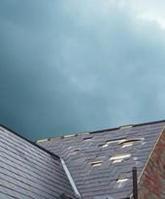UK roofing industry responds to climate change
 As the UK recovers from January storms that saw the worst gales in seventeen years, one of the country’s leading roof tile manufacturers, Sandtoft Roof Tiles has highlighted the significant impact that Britain’s changing climate will have on the roofing industry. According to Simon Oldridge, managing director at Sandtoft, the rising unpredictability of weather in the UK will place added focus on the fixing of roof tiles and slates.
As the UK recovers from January storms that saw the worst gales in seventeen years, one of the country’s leading roof tile manufacturers, Sandtoft Roof Tiles has highlighted the significant impact that Britain’s changing climate will have on the roofing industry. According to Simon Oldridge, managing director at Sandtoft, the rising unpredictability of weather in the UK will place added focus on the fixing of roof tiles and slates.Mr Oldridge commented: “Global warming is fuelling changes in the UK’s weather systems that are already having an impact on the roofing industry. January saw hundreds of millions of pounds worth of damage in the UK, and the frequency of these conditions is widely expected to increase in the future.”
According to the Association of British Insurers, climate change could see annual losses from the three major storm types affecting the UK increase by two thirds to £13.85billion by 2080. Simon Oldridge continued: “Measures are already being taken by the roofing industry to help minimise the damage caused to roofs by extreme weather conditions such as those experienced in January. For example, the new zonal fixing method introduced last October will play a major part in creating secure roofs that will withstand increasing demands.”
The zonal method for specifying roof tile fixings provides the user with a map dividing the UK into 3 wind ‘zones’. By taking the appropriate wind zone and some other simple considerations such as roof pitch and site altitude a suitable fixing specification can be read from the supplied Zonal fixing table without the need for any calculations. The zonal system was developed by an industry committee of experts headed by the National Federation of Roofing Contractors with representatives from the Concrete Tile Manufacturer’s Association, Clay Roof Tile Council, Building Research Establishment, National Building Specification, National House Builders Council and Zurich.
Although welcomed by roof tile manufacturers such as Sandtoft, the simplicity of the system means that some specifications will be deemed conservative, but this is necessary to ensure 100% compliance with British Standards. However, Simon Oldridge believes the changing conditions in the UK justify greater caution from the industry:
“Fixing specifications that may seem conservative now will perform a pivotal role in helping to withstand the harsher conditions that will arise in the future, especially with regards to severe winds such as those we experienced in January,” he explained.
“And just as fixing methods have changed, mechanical fixing products will help to create more robust roofs. Dry fix systems such as Sandtoft’s new RollRidge product, provide stronger fixing solutions than traditional mortar, and as the UK winters look set to get wetter, the fact they can be fixed in all weathers is another advantage.”
Aside from the company’s recommendations for creating more secure roofs, Sandtoft has also taken a number of steps to reduce its own contribution to climate change including the switch to 100% green electricity for all its operations. This and other environmental pledges are highlighted in Sandtoft’s Green Resolution; an environmental action plan issued by the company in January.
Simon Oldridge added: “The burning of fossil fuels is the primary catalyst for climate change, and as an industry the roofing sector has a responsibility not only to react to Global warming, but also to help combat it through reducing our carbon emissions.”

